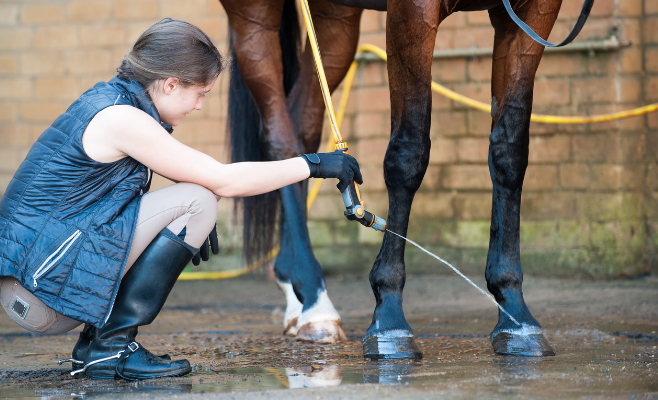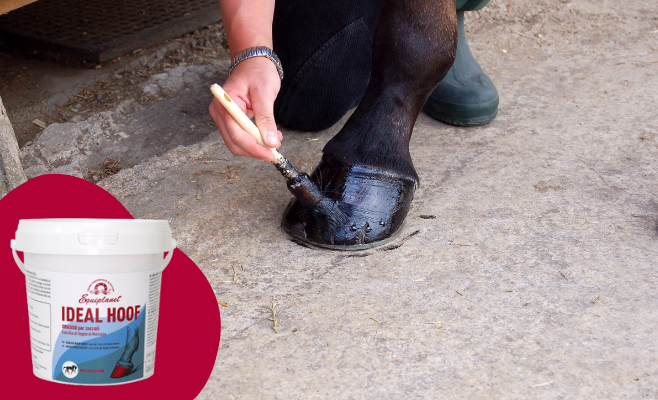
The Orphan Foal: Management and Feeding
28 March 2022
Horse management in summer in 10 steps
29 June 2022Horse hoof care: 5 tips from Equiplanet

Hoof care must necessarily be part of the daily habits of horse management, such as feeding, supplementing with complementary feed, washing and grooming. The horse’s foot has several functions: it supports the horse’s weight, disperses the energy of impact with the ground and protects the sensitive structures contained within it. It is therefore understandable how essential it is to take care of the horse’s hoof.

How to maintain a functional hoof?
1) Box cleaning and quality bedding
The place where the horse usually spends the most time (paddock or box) can pose a threat to the well-being of the horse’s hoof, as it risks becoming a dangerous pabulum for microorganisms to grow and multiply. This is especially true if the box is not properly cleaned and sanitised.

For hoof care, it is therefore essential to use suitable bedding, which can be made of straw, shavings or other commercially available materials and must be distributed in the box in an appropriate quantity. Droppings must also be removed several times a day, especially urine, which tends to keep the horse’s hoof wet, making it too wet and therefore soft.
2) Hoof inspection by a farrier

Taking care of the horse’s hoof includes correct farriery operations, which have an important impact on the athletic career of a sport horse. Hoof trimming and shoeing are routine operations for our horses: every 45-50 days it is important to have the horse’s hoof checked by an experienced farrier.
3) Right feeding for hoof care
When setting up a feeding plan, the body condition score, the type of work done, on what terrain, the quality and thickness of the hoof and whether or not and if so, whether the ration should be supplemented with complementary feeds should be evaluated. Quality protein (more specifically, the essential amino acid methionine), copper and zinc all play important roles in hoof integrity.

If a horse is fed only forage and possibly a cereal mix, it may suffer from deficiencies in these nutrients. This is why it is always best to add a balancer to the ration to provide quality protein, amino acids, vitamins and trace elements. Mac Breed is a complementary feed that meets all the needs for the physiological maintenance of the hoof.

There are micronutrients that are sometimes necessary for hoof care. For several years, biotin has been in common use in horses because of its effect on growth and hoof health. Biotin is usually added to the ration when the owner or farrier notices a fragile hoof with cracks, splintering, flaking of the lower parts and difficulty in maintaining the shoeing. In cases of hoof problems, the use of biotin should be continued for longer periods (6-9 months) as biotin supplementation increases the consistency and strength of the horny tissue but does not affect the growth rate

Biotinvet 10,000 is a dietary mineral feed for hoof and skin regeneration that provides 10,000 mg biotin per kg of product. For this dietary feed for horses for hoof and skin regeneration, the recommended daily amount is 20 g per day, to provide 200 mg of biotin per day per horse. Biotinvet 10,000 also provides Methionine and Zinc, which, as we have already mentioned, play a key role in the integrity of the hoof.
4) Daily cleaning for hoof care

Hoof cleaning is carried out before and after riding, using a hoof pick. This removes any stones, debris and excess dirt that could cause problems for the horse in the long run. Careful brushing also gives owners the opportunity to examine the animal’s feet from heel to toe on a regular basis, noting any abnormalities at an early stage. Finally, these manual skills reserved for the horse only strengthen the relationship and understanding between horse and rider.
5) Using grease for hoof care

Grease applied to the hoof acts as a barrier that isolates the outside from the optimal physiological moisture condition inside. The equine hoof has a self-regulating moisture system if all the health constants of the environment and the hoof itself are maintained. The fat also protects the hoof from the weakness created by wet urine or wet ground and fortifies the hoof against cracking. For horses that work daily and are regularly showered, it is preferable to apply the grease before they are showered, as this will allow the water to run off the hoof without wetting it further.

Ideal Hoof is a hoof grease based on Cod Liver Oil and if used regularly will help to strengthen the hoof due to its vitamin content which contributes to hoof regrowth. Ideal Hoof does not attract insects and protects the hoof from external agents by allowing it to breathe. Ideal Hoof can also be applied in any season because it does not change its consistency (freezing or melting). Simply apply with a brush to the entire dry or wet hoof, in the crown and under the secton after cleaning the area.
Hoof care is important in order not to impair the athletic performance of our horses. If you would like personalised advice for your stable or your horse, send an email to info@equiplanet.it
Follow us on Facebook and Instagram to stay updated on all Equiplanet news.
Bibliography
- No hoof no horse? Equine vet. J. (1995) 27 (3) 166-168
- Hoof horn abnormalities in Lipizzaner horses and the effect of dietary biotin on macroscopic aspects of hoof horn quality. H Josseck, 1995
- The long-term influence of biotin supplementation on hoof horn quality in horses. Geyer H, 1994
- Basic farriery for the performance horse. Stephen E O’Grady, 2008
- Hoof Supplement or Ration Balancer: Which Does My Horse Need? Clair Thunes, 2021

